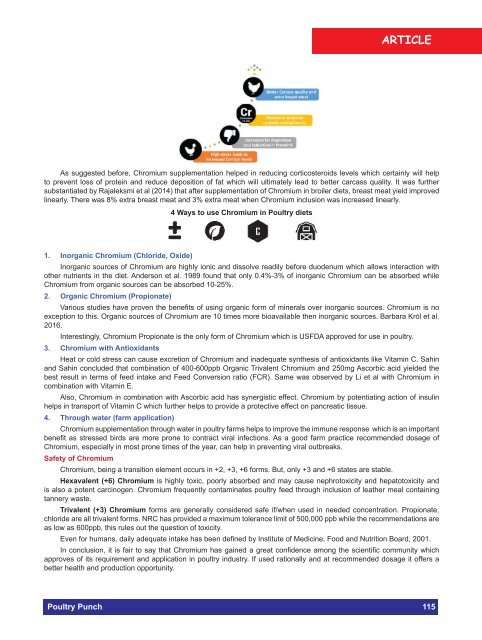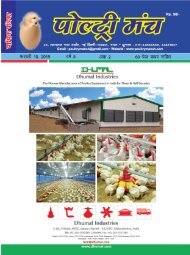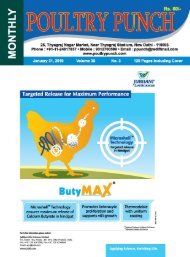POULTRY PUNCH - FEBRUARY 2019
POULTRY PUNCH - FEBRUARY 2019
POULTRY PUNCH - FEBRUARY 2019
- No tags were found...
You also want an ePaper? Increase the reach of your titles
YUMPU automatically turns print PDFs into web optimized ePapers that Google loves.
ARTICLE<br />
As suggested before, Chromium supplementation helped in reducing corticosteroids levels which certainly will help<br />
to prevent loss of protein and reduce deposition of fat which will ultimately lead to better carcass quality. It was further<br />
substantiated by Rajaleksmi et al (2014) that after supplementation of Chromium in broiler diets, breast meat yield improved<br />
linearly. There was 8% extra breast meat and 3% extra meat when Chromium inclusion was increased linearly.<br />
4 Ways to use Chromium in Poultry diets<br />
1. Inorganic Chromium (Chloride, Oxide)<br />
Inorganic sources of Chromium are highly ionic and dissolve readily before duodenum which allows interaction with<br />
other nutrients in the diet. Anderson et al. 1989 found that only 0.4%-3% of inorganic Chromium can be absorbed while<br />
Chromium from organic sources can be absorbed 10-25%.<br />
2. Organic Chromium (Propionate)<br />
Various studies have proven the benefits of using organic form of minerals over inorganic sources. Chromium is no<br />
exception to this. Organic sources of Chromium are 10 times more bioavailable then inorganic sources. Barbara Król et al.<br />
2016.<br />
Interestingly, Chromium Propionate is the only form of Chromium which is USFDA approved for use in poultry.<br />
3. Chromium with Antioxidants<br />
Heat or cold stress can cause excretion of Chromium and inadequate synthesis of antioxidants like Vitamin C. Sahin<br />
and Sahin concluded that combination of 400-600ppb Organic Trivalent Chromium and 250mg Ascorbic acid yielded the<br />
best result in terms of feed intake and Feed Conversion ratio (FCR). Same was observed by Li et al with Chromium in<br />
combination with Vitamin E.<br />
Also, Chromium in combination with Ascorbic acid has synergistic effect. Chromium by potentiating action of insulin<br />
helps in transport of Vitamin C which further helps to provide a protective effect on pancreatic tissue.<br />
4. Through water (farm application)<br />
Chromium supplementation through water in poultry farms helps to improve the immune response which is an important<br />
benefit as stressed birds are more prone to contract viral infections. As a good farm practice recommended dosage of<br />
Chromium, especially in most prone times of the year, can help in preventing viral outbreaks.<br />
Safety of Chromium<br />
Chromium, being a transition element occurs in +2, +3, +6 forms. But, only +3 and +6 states are stable.<br />
Hexavalent (+6) Chromium is highly toxic, poorly absorbed and may cause nephrotoxicity and hepatotoxicity and<br />
is also a potent carcinogen. Chromium frequently contaminates poultry feed through inclusion of leather meal containing<br />
tannery waste.<br />
Trivalent (+3) Chromium forms are generally considered safe if/when used in needed concentration. Propionate,<br />
chloride are all trivalent forms. NRC has provided a maximum tolerance limit of 500,000 ppb while the recommendations are<br />
as low as 600ppb, this rules out the question of toxicity.<br />
Even for humans, daily adequate intake has been defined by Institute of Medicine, Food and Nutrition Board, 2001.<br />
In conclusion, it is fair to say that Chromium has gained a great confidence among the scientific community which<br />
approves of its requirement and application in poultry industry. If used rationally and at recommended dosage it offers a<br />
better health and production opportunity.<br />
Poultry Punch 115






